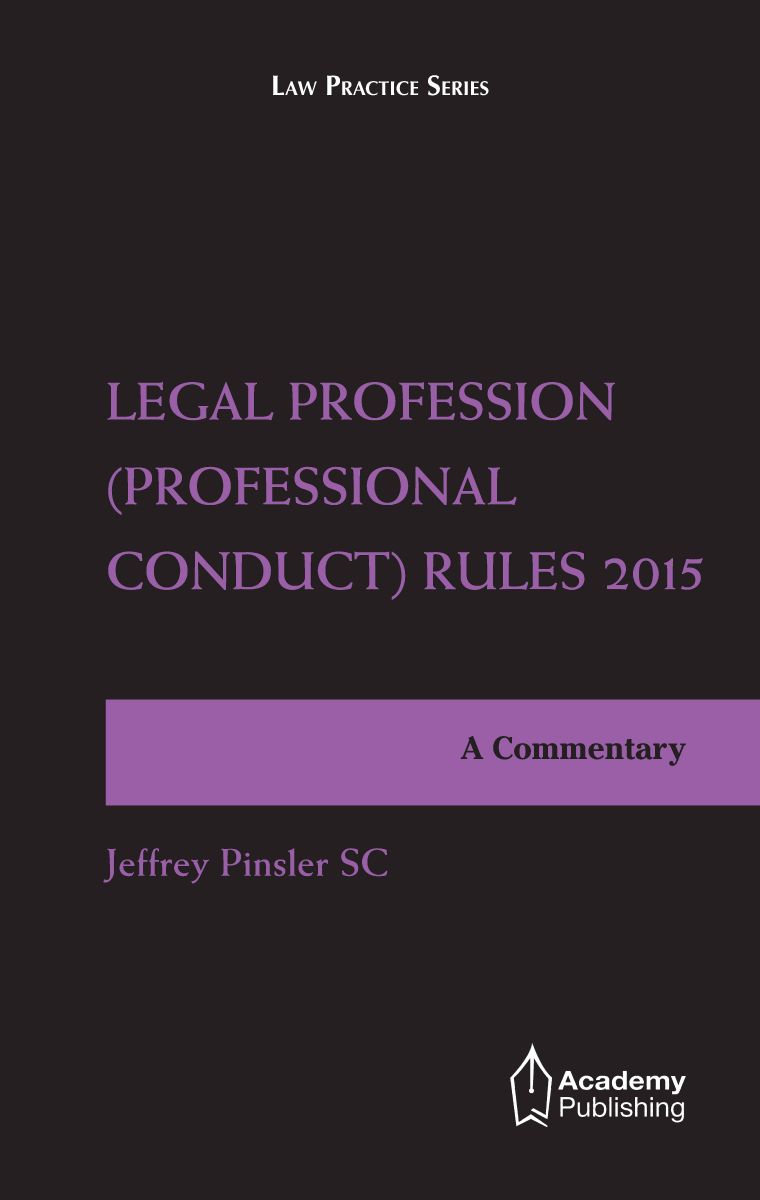Legal Profession (Professional Conduct) Rules 2015 – A Commentary by Jeffrey Pinsler, SC

The Legal Profession (Professional Conduct) Rules 2015 (the “PCR 2015”) came into force on 18 November 2015 replacing the old set of rules that had been in place since 1998. The PCR 2015 is novel in many ways, one of which is that it introduces the concept of a principles-based approach in setting out ethical duties and responsibilities as a guide to interpreting specifically-worded rules governing the conduct of lawyers. For this approach, it is obvious that its drafters took inspiration from Professor Jeffrey Pinsler’s 2007 publication, Ethics and Professional Responsibility: A Code for the Advocate and Solicitor, which focused on the ethical principles underlying the previous PCR.
Professor Pinsler’s latest contribution to the area of ethics and professional responsibility is the hugely useful Legal Professional (Professional Conduct) Rules 2015, A Commentary. It is structured in a manner that makes it extremely handy to the practising lawyer. It comprehensively annotates each rule of the PCR 2015 in the order that they appear in the rules, making research easy and quick. The detailed annotations to each rule makes references to judgments, extra-judicial pronouncements, provisions in the Legal Profession Act, other related subsidiary legislation, applicable practice directions, rulings and guidance notes issued by the Law Society, applicable practice directions issued by the Court, and also examples of how errant lawyers have found to have transgressed the rule in question or other similar rules. This enables quick references and quick answers. Time, after all, is a precious commodity when one is in search of an answer to a thorny question of professional conduct that has arisen in the course of work of a practising lawyer.
The book starts with an overview of the regulatory framework governing the professional conduct of lawyers and roles played by various regulatory bodies such as the Law Society and the newly formed Professional Conduct Council and Legal Services Regulatory Authority. Professor Pinsler then deals with the scope of application of the PCR 2015. At the beginning of the annotation for each rule, he reminds the reader whether the rule in question applies to lawyers who hold a practising certificate, lawyers who practise foreign law in a Joint Law Venture or foreign law practice, lawyers who are admitted on an ad hoc basis, foreign lawyers who are entitled to conduct Singapore International Commercial Court proceedings, or foreign lawyers entitled to practice both Singapore law and foreign law in Singapore. Given the different categories of legal practitioners subject to regulation, this is very useful to the user who needs to navigate the PCR 2015 quickly to search for an answer as to whether one’s professional conduct is governed by a particular ethical rule.
It is no surprise that Professor Pinsler expertly analyses and explains the general ethical principles set out in Rule 4 of PCR 2015 that guide the interpretation of the rest of the rules. He examines the source of these general principles (often, judicial pronouncements) and show how they form the foundation of various specific rules. Another aspect of the book which I found enlightening is how he has drawn the reader’s attention to the content and wording of specific rules in the PCR 2015, which differ from the earlier set of rules. For example, the concept of “gross overcharging” of a client has been done away with and Professor Pinsler examines the new standard of determining when a lawyer may be found to have overcharged his client. Another example is the new rule on conflicts dealing with former clients (Rule 21 PCR 2015) which focuses on confidential information, rather than the much maligned Rule 31 of the previous set of rules. He explains how this different approach provides more precision and clarity. Yet another example is the expanded rule on executive appointments (Rule 34), which would interest lawyers with business interests outside of their legal practice.
What I found interesting is that Professor Pinsler also deals with lesser known issues such as the Court’s inherent power to deal with ethical compromise in the course of legal proceedings, as well as the consequences of breaches of lawyers’ undertakings to the Court and to other lawyers. He also devotes a portion of the book to explain how a respectful advocate should behave and speak in the course of conducting proceedings in Court, which provides good guidance to the young litigator starting out in practice. Additionally, the appendix of the book examines the Code of Ethics that lawyers registered to appear before the Singapore International Commercial Court have to adhere to in proceedings before that Court.
Finally, it is pertinent that Professor Pinsler also examines in some detail Rule 35, which introduces the concept of the management of a law practice being professionally responsible for having adequate systems, policies and controls in place to deal with client’s money, conflicts of interest and client confidentiality. This is certainly a rule that may cause some consternation to those involved in law firm management, but they will gain considerable help from Professor Pinsler’s analysis as to what is needed for compliance.
All in all, I would strongly recommend this book to all legal practitioners. It is an essential text that should be within easy reach of your desk at all times.
► Ang Cheng Hock, SC
Partner
Allen & Gledhill LLP
Legal Profession (Professional Conduct) Rules 2015 – A Commentary is available from the Singapore Academy of Law https://www.sal-e.org.sg/pre-order-legal-profession-professional-conduct-rules-2015.

